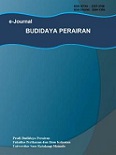Uji fitokimia dan aktivitas antimikroba ekstrak kulit pisang kepok (Musa paradisiaca) terhadap bakteri Aeromonas hydrophila
DOI:
https://doi.org/10.35800/bdp.11.1.2023.42192Keywords:
plant products, disease, maceration, phytochemical test, inhibition zoneAbstract
This research was conducted to qualitatively analyze the phytochemical content of kepok banana (Musa paradisiaca) peel extract and the effectivity of the extract as antibacterial against Aeromonas hydrophila. Fresh yellow color banana peels were washed, drained, then cut into pieces, crushed and dried at room temperature. Extraction was carried out by maceration method with 70% and 95% ethanol as solvent. A total of 90 g was put in an elemeyer glass then added with solvent until all the banana peels were submerged. The immersion time was 3x24 hours at room temperature while stirring occasionally so that the extraction occurs properly. Furthermore, the extract was filtered with Whatman paper no. 42 to separate the residue from the filtrate. The filtrate was then concentrated using a rotary evaporator. Phytochemical examined consisted of alkaloid, flavonoid, sternoid, triterpenoid, saponin, and tannin. Inhibition test against A. hydrophila was carried out by disc diffusion method using 5 different extract concentrations as treatments, namely A: 0%, B:10%, C:20%, D:30%, E:40%, F:50%. In the inhibition test, the paper disc was dipped in each treatment and then placed on agar media previously stocked with bacteria. The inhibitory zone was measured based on the clear area formed around the disc and observed at 24, 48, and 72 hours. Phytochemical test found that phenol and tannin were only detected in extracts with 95% ethanol while terpenoids and steroids were only found in ethanol70%.  Flavonoid was detected in the extract using either ethanol70% and 95%. The results of the inhibitory test showed that the kepok banana peel extract could inhibit the growth of A. hydrophila bacteria after 48 hours of incubation. Inhibition zones formed at both 48 hours and 72 hours tended to increase in line with the increase in concentration even though the inhibitory power produced was categorized as "medium".
Downloads
Published
Issue
Section
License
Copyright (c) 2022 e-Journal BUDIDAYA PERAIRAN

This work is licensed under a Creative Commons Attribution-NonCommercial 4.0 International License.







